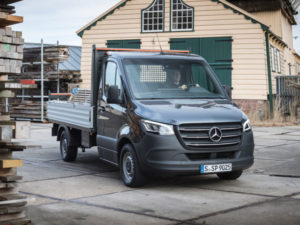With front- and rear-wheel drive, the new Sprinter should appeal to all, says Dan Gilkes.

SECTOR Large van Load volume 7.8m3-17m3 POWER 114-177bhp Gross weight 3.0-5.5 tonnes CO2 178-253g/km=
We’ve finally managed to get behind the wheel of the new Mercedes-Benz Sprinter and, without need for a spoiler alert, it is unsurprisingly a very good van indeed. We’ve reported on the technology available, the connectivity and the new interior, which is dominated by a huge central panel with a beautiful 10.25-inch touchscreen in higher trim models. What we haven’t been able to report on, until now, is the way in which this third generation Sprinter drives.
That’s partly because the new van breaks with Mercedes tradition and offers front-wheel drive as an option, alongside the previous rear-drive format. Mercedes has turned its own 2.1-litre diesel engine through 90° for the front-wheel drive models, while it retains the north-south layout in rear-wheel drive vans.
That means those opting for the rear-driven Sprinter get the usual choice of 114bhp, 143bhp and 163bhp from the four-cylinder engine, with a six-speed manual gearbox or Merc’s seven-speed 7G-Tronic Plus. There is also the 3.0-litre V6 engine in rear-drive, offering 190bhp and mated to the automatic transmission as standard.
Go for front-wheel drive and you can have 114bhp or 143bhp too, plus there’s a 177bhp rating for motorhome conversions. However, the big news is that as well as a six-speed manual, front-driven vans can also be supplied with a nine-speed automatic, which is even smoother to drive than the seven-speed gearbox.
There is little to differentiate front from rear-drive in appearance, but the front-drive vans benefit from an 80mm lower loading sill, making it easier to get in and out of the load compartment. They are also on average around 50kg lighter than the rear-drive vans, boosting payload.
That said, while front drive models have gross weights of 3.0-4.1 tonnes, the rear-driven vans go from 3.0-5.5 tonnes GVW. Maximum towing weight is 2.0-tonnes for FWD models and 3.5-tonnes on RWD vans.
It’s perhaps a sign of how good the van is, that it is hard to tell in normal driving which wheels are doing the hard work, unless you happen to have nine-speeds at your
disposal. Both front- and rear-drive Sprinters are quiet, smooth and just as easy to pilot through town as they are on the motorway.
The adoption of electric power steering has allowed Mercedes to incorporate a host of safety and driver assistance systems, such as Active Lane Keeping Assist. Active Distance Assist Distronic will also maintain the van’s distance to the vehicle in front automatically, coming to a complete halt and then moving away again in vans equipped with an automatic transmission, making life easier for the driver in heavy traffic conditions.
There are too many details to list here, but suffice it to say that specifying a new Sprinter is unlikely to be a simple job for fleet managers, the myriad variations on offer will require some time to fully assess.
What we think
We expected the third generation Mercedes-Benz Sprinter to be good and there was no need for buyers to be worried, unlike the competition.

